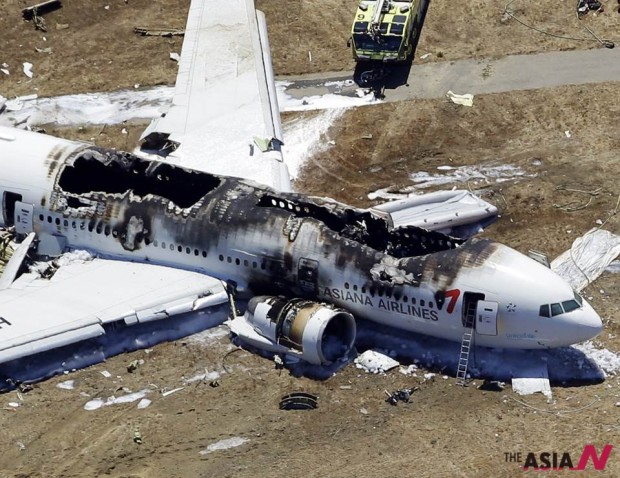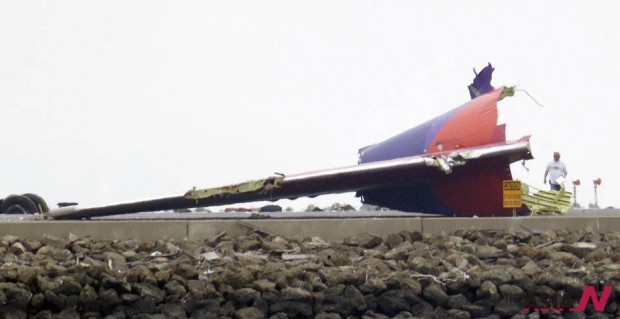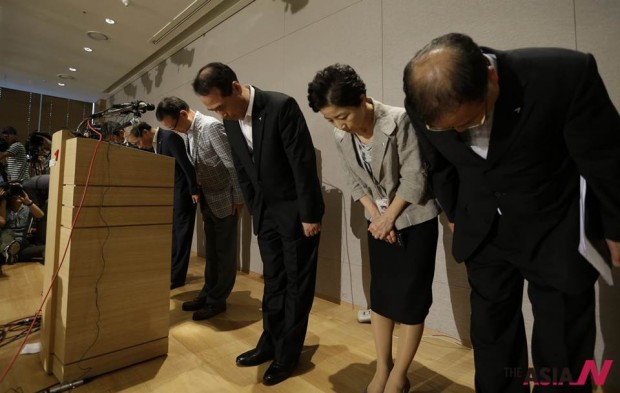S. Korean airplane crashs while landing at San Francisco Int’l Airport, 2 dead

This aerial photo shows the wreckage of the Asiana Flight 214 airplane after it crashed at the San Francisco International Airport in San Francisco, Saturday, July 6, 2013. (Photo : AP Photo/Marcio Jose Sanchez)
A federal safety official said Sunday the cockpit voice recorder from Asiana Flight 214 showed the jetliner received a warning that it could stall because it was flying too slowly and tried to increase its speed before it crashed.
National Transportation Safety Board chief Deborah Hersman said at a news conference Sunday the recorder also showed the Boeing 777’s crew called to abort the landing about 1.5 seconds before impact.
National Transportation Safety Board chief Deborah Hersman said at a briefing on the crash of the Boeing 777 said the plane was traveling at speeds well below the target landing speed of 137 knots per hour, or 157 mph.
“We’re not talking about a few knots,” she said.
Hersman also said the aircraft’s stick shaker – a piece of safety equipment that warns pilots of an impending stall – went off moments before the crash. The normal response to a stall warning is to increase speed to recover control.
There was an increase in speed several seconds before the crash, she said, basing her comments on an evaluation of the cockpit voice recorder and flight data recorder. They contain hundreds of different types of information on what was happening to the plane.
And at 1.5 seconds before impact, there was a call for an aborted landing, she said.

An investigator looks at the tail of Asiana Flight 214 on Sunday, July 7, 2013, after the passenger jet crashed at the San Francisco International Airport in San Francisco on Saturday. (Photo : AP Photo/Marcio Jose Sanchez)
Pilots normally try to land at the target speed, in this case 137 knots, plus an additional five more knots, said Bob Coffman, an American Airlines captain who has flown 777s. He said the briefing raises an important question: “Why was the plane going so slow?”
The plane’s Pratt and Whitney engines were on idle, Hersman said. But the normal procedure in the Boeing 777, a wide-body jet, would be to use the autopilot and the throttle to provide power to the engine all the way through to landing, Coffman said.
There was no indication in the discussions between the pilots and the air traffic controllers that there were problems with the aircraft.
Hersman earlier said investigators are looking into what role the shutdown of a key navigational aid may have played in the crash. She said the glide slope – a ground-based aid that helps pilots stay on course while landing – had been shut down since June.
She said pilots were sent a notice warning that the glide slope wasn’t available. Hersman told CBS’ “Face the Nation” that there were many other navigation tools available to help pilots land. She says investigators will be “taking a look at it all.”
Since the crash, clues have emerged in witness accounts of the planes approach and video of the wreckage, leading one aviation expert to say the aircraft may have approached the runway too low and something may have caught the runway lip – part of a seawall at the foot of the runway.
San Francisco is one of several airports around the country that border bodies of water that have walls at the end of their runways to prevent planes that overrun a runway from ending up in the water.
Since the plane was about to land, its landing gear would have already been down, said Mike Barr, a former military pilot and accident investigator who teaches aviation safety at the University of Southern California.

Asiana Airlines President and CEO Yoon Young-doo, fourth from right, and board members bow during a press conference after a crash landing of an Asiana Airlines flight at San Francisco airport, at its head office in Seoul, South Korea, Sunday, July 7, 2013. The Boeing 777 slammed into the runway on Saturday morning, breaking off its tail and catching fire before slumping to a stop that allowed the lucky ones to flee down emergency slides into thick smoke and a trail of debris even as firefighters doused the flames that burned through the fuselage with foam and water. (Photo : AP Photo/Lee Jin-man)
It’s possible the landing gear or the tail of the plane hit the seawall, he said. If that happened, it would effectively slam the plane into the runway.
Noting that some witnesses reported hearing the plane’s engines rev up just before the crash, Barr said that would be consistent with a pilot who realized at the last minute that the plane was too low and was increasing power to the engines to try to increase altitude.
Barr said he could think of no reason why a plane would come in to land that low.
“When you heard that explosion, that loud boom and you saw the black smoke … you just thought, my god, everybody in there is gone,” said Ki Siadatan, who lives a few miles away from the airport and watched the plane’s “wobbly” and “a little bit out of control” approach from his balcony.
“My initial reaction was I don’t see how anyone could have made it,” he said.
Inside the plane, passenger Vedpal Singh, who had a fractured collarbone and whose arm was in a sling, was sitting in the middle of the aircraft with his family. He said there was no forewarning from the pilot or any crew members before the plane touched down hard and he heard a loud sound.
“We knew something was horrible wrong,” said a visibly shaken Singh. He said the plane went silent before people tried to get out anyway they could. His 15-year-old son said luggage tumbled from the overhead bins.
Passenger Benjamin Levy said it looked to him that the plane was flying too low and too close to the bay as it approached the runway. Levy, who was sitting in an emergency exit row, said he felt the pilot try to lift the jet up before it crashed.
He said he thought the maneuver might have saved some lives. “Everybody was screaming. I was trying to usher them out,” he recalled of the first seconds after the landing. “I said: `Stay calm, stop screaming, help each other out, don’t push.”‘
Wen Zhang said she could feel the plane’s tail hit the ground. Baggage was falling around her, people were screaming and the aisle window broke.
Zhang picked up her 4-year-old son, who had hit the seat in front of him and broke his leg. Unhurt, she carried him through the hole where the bathroom was and went out onto the tarmac.
“I had no time to be scared,” she said.
Xu Da, a product manager at an Internet company in Hangzhou, China, said he was sitting with his wife and teenage son near the back of the plane. When he felt the plane hit the ground, he said, oxygen masks dropped down.
And when he stood up in a cabin, he could see the tail where the galley was torn away, leaving a gaping hole through which he could see the runway. After escaping, they watched the plane catch fire, and firefighters hose it down. They suffered some cuts and have neck and back pain.
“I just feel lucky,” he said. “We are so lucky we sit beside the tail and we can leave the plane in the first place.”
By the time the flames were out, much of the top of the fuselage had burned away. The tail section was gone, with pieces of it scattered across the beginning of the runway. One engine appeared to have broken away.
The flight originated in Shanghai, China, and stopped over in Seoul, South Korea, before making the nearly 11-hour trip to San Francisco, airport officials said. The airline said there were 16 crew members aboard and 291 passengers. Thirty of the passengers were children.
San Francisco Fire Department Chief Joanne Hayes-White said 19 people remain hospitalized, six of them in critical condition.
She said at a news conference outside San Francisco General Hospital the two 16-year-old girls who died were found on either side of the plane near the “front middle.” Investigators are determining whether they were alive or dead when rescuers reached the scene.
Hayes-White said first responders told her they saw people at the edge of the bay dousing themselves with water, possibly to cool burn injuries.
San Francisco General Hospital Chief of Surgery Margaret Knudson said at least two people injured that were treated there are paralyzed and two others suffered road rash-type injuries suggesting they were dragged.
She said doctors at the hospital have also seen abdominal and orthopedic injuries and head trauma. Patients with severe abdominal injuries and spinal fractures appear to have suffered them from being thrown forward and back while restrained by seat belts.
South Korean government said the passengers included 141 Chinese, 77 South Koreans, 61 Americans, three Canadians, three from India, one Japanese, one Vietnamese and one from France, while the nationalities of the remaining three haven’t been confirmed.
Chinese state media identified the dead as two 16-year-old girls from China’s eastern Zhejiang province. China Central Television cited a fax from Asiana Airlines to the Jiangshan city government. They were identified as Ye Mengyuan and Wang Linjia.
At least 70 Chinese students and teachers were on the plane heading to summer camps, according to education authorities in China.
Asiana President Yoon Young-doo said at a televised news conference that it will take time to determine the cause of the crash. But when asked about the possibility of engine or mechanical problems, he said he doesn’t believe they could have been the cause.
He said the plane was bought in 2006 but didn’t provide further details. Asiana officials later said the plane was also built that year.
Yoon also bowed and offered an apology, “I am bowing my head and extending my deep apology” to the passengers, their families and the South Korean people over the crash, he said.
Four pilots were aboard the plane and they rotated on a two-person shift during the flight, according to The Ministry of Land, Infrastructure and Transport in South Korea. The two who piloted the plane at the time of crash were Lee Jeong-min and Lee Gang-guk.
Yoon, the Asiana president, described the pilots as “skilled,” saying three had logged more than 10,000 hours each of flight time. He said the fourth had put in almost that much time, but officials later corrected that to say the fourth had logged nearly 5,000 hours. All four are South Koreans. <AP/NEWSis>



















































